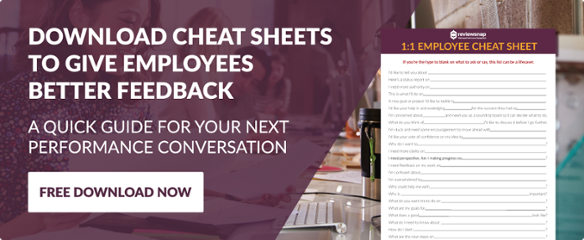The Ghosts of Performance Management Past

“I will live in the Past, the Present, and the Future. The Spirits of all Three shall strive within me. I will not shut out the lessons that they teach!” -Charles Dickens, A Christmas Carol
The phrase “living in the past” has gathered a negative connotation, equating to the inability to adapt to changing times, habits, and technologies. This sentiment isn’t lost on performance management programs, where only 8% of companies think their appraisal process provides value to the organization and/or employee.
Tweet This: Only 8% of companies think their appraisal process provides value to the org. & employees. Read more:
Luckily, the HR professionals and people managers of the world aren’t as miserable as dear, old Mr. Ebenezer Scrooge. Companies are listening to their employees and adjusting their approach before losing any sleep over a visit from the ghosts of performance management past. Deloitte reported 89% of respondents changed their performance management process this year, or plan to change it within the next 18 months. If you’re one of the 11% still waiting for a spectral wake up call, we’ll happily provide a little history lesson to help you avoid any lost sleep…
PERFORMANCE MANAGEMENT PAST
The 40s
The, now controversial, practice of annual performance reviews originated in the 1940s when about 60% of US companies were using appraisals to measure and document employee performance (on an individual scale) so that rewards could be allocated. The alternative, however, included punishing those who were not meeting expectations with a discharge or transfer.
The 50s, 60s and 70s
In the 1960s, a focus on development pushed companies to have appraisal discussions that included more direction on both accountability and growth, but eventually increased inflation rates of the 1970s changed that.
Theory Y Approach to Management: Coined by social psychologist, Douglas McGregor, the Theory Y approach was a system that encouraged goal-setting between manager and employee, with the goal of strength development. The goal was to use the defined steps, in addition to self-assessments, to inspire employees to realize their potential through personal motivation instead of material rewards or punishment.
The 80s
By the 1980s, Jack Welch of General Electric had championed forced ranking in civilian workplaces, which shifted the focus away from development, and back to employee accountability.
Forced Ranking: First used by the Army in World War II, this process takes an annual look at employees to identify the best, and worst, performers. The practice uses person-to-person comparisons in hopes of improving the workforce as a whole. Some believe this technique fosters competition and hurts collaboration; ultimately, how well it works is still up for debate, but we can say that GE has long abandoned the technique.
The 90s and Aughts
With the 1990s came the infamous War on Talent (title credits to McKinsey). During this time, organizations began to believe that some employees were intrinsically more talented than others and that it was pertinent those individuals be found and encouraged with rewards. With that belief came a larger focus on employee engagement. This held strong into the 2000s where performance reviews worked to uphold employee accountability and reward, but again times were changing.
PERFORMANCE MANAGEMENT PRESENT AND FUTURE
Although this is about the ghosts of the past, the present and the future hold merit. Especially since the last decade and a half has nearly turned performance management on its head.
Today, 58% of companies believe the annual performance review system is broken and ineffective. The pattern of appraisals around employee accountability to appraisals around employee development and back again has only continued. More and more organizations are building mentorships and coaching programs, providing feedback (real-time and otherwise) to push better appreciation processes. The 2016 Top Employers HR Best Practices Survey reports..
- 70% of top employers feel an effective two-way performance dialogue between employee and manager is a top performance management objective
- 91% of top employers make employee recognition an ongoing, formally defined activity in their performance management cycle
- 85% of top employer organizations evaluate employees on a continual basis (at least twice per year)
- 92% of top employers report that they allow employees to play an active role in developing individual annual goals
- 93% of top employer managers are instructed and trained to provide open and constructive performance feedback to employees on an ongoing basis
Tweet This: What are your predictions for the 2016 Top Employers HR Best Practices results? Take a look:
In the past, performance management was less about management and more about yearly discussions fueled by the basic understandings of employees. When it comes to managing a healthy and productive workforce, organizations are pushing past tradition and including far more professional development with performance management in between. Download our report, The Truth About Performance Appraisals, to see a more in-depth look at the performance management shift.
Of course, all those additional tactics introduces an increased need for organization. That’s where technology, like Reviewsnap, steps in. Our performance management platform brings reviews, 360-degree feedback, compensation, and development all into one easy-to-use software.
Recent Posts:

